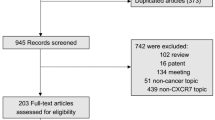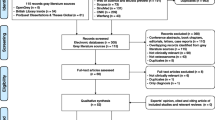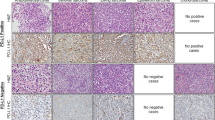Abstract
The prognostic significance of CXC chemokine receptor 4 (CXCR4) in patients with bone and soft tissue sarcomas remains controversial. To investigate the impact of its expression on survival and clinicopathological features, we performed a meta-analysis. Comprehensive literature searches were conducted in PubMed, Web of Science, Embase and Cochrane Library for relevant studies. In total, 12 studies with 997 sarcoma patients were included. CXCR4 expression was found to be significantly associated with poor overall survival (HR 2.37, 95 % CI 1.86–3.01; P < 0.001). Further, when the analysis was stratified by histological subtypes (bony sarcoma including osteosarcoma and Ewing sarcoma and soft tissue sarcoma including synovial sarcoma and rhabdomyosarcoma), statistical analysis method (multivariate analysis and univariate analysis) and CXCR4 measuring method (IHC or RT-PCR), the significant correlation to poor overall survival was also observed except for that in Ewing sarcoma and RT-PCR groups. As for clinicopathological features, CXCR4 expression was significantly associated with higher rate of metastasis (OR 6.97, 95 % CI 2.28–21.31; P = 0.001) and higher tumor stage (OR 7.55, 95 % CI 1.25–45.47; P = 0.027), but not associated with gender, age and tumor site. In conclusion, CXCR4 expression may be an effective predictive factor of poor prognosis and clinicopathological features for bone and soft tissue sarcomas. Further studies are needed to validate our findings.


Similar content being viewed by others
References
Skubitz KM, D’Adamo DR. Sarcoma. Mayo Clin Proc. 2007;82(11):1409–32.
Hwang JS, Mehta AD, Yoon RS, et al. From amputation to limb salvage reconstruction: evolution and role of the endoprosthesis in musculoskeletal oncology. J Orthop Traumatol. 2014;15(2):81–6.
Nakamura T, Matsumine A, Yamakado K, et al. Lung radiofrequency ablation in patients with pulmonary metastases from musculoskeletal sarcomas. Cancer. 2009;115(16):3774–81.
Luetke A, Meyers PA, Lewis I, et al. Osteosarcoma treatment—Where do we stand? A state of the art review. Cancer Treat Rev. 2014;40(4):523–32.
Wang N, He YL, Pang LJ, et al. Down-regulated E-cadherin expression is associated with poor five-year overall survival in bone and soft tissue sarcoma: results of a meta-analysis. PLoS One. 2015;10(3):e0121448. doi:10.1371/journal.pone.0121448.
Burger JA, Kipps TJ. CXCR4: a key receptor in the crosstalk between tumor cells and their microenvironment. Blood. 2006;107(5):1761–7.
Kryczek I, Wei S, Keller E, et al. Stroma-derived factor (SDF-1/CXCL12) and human tumor pathogenesis. Am J Physiol Cell Physiol. 2007;292(3):C987–95.
de Oliveira KB, Guembarovski RL, Guembarovski AM, et al. CXCL12, CXCR4 and IFNgamma genes expression: implications for proinflammatory microenvironment of breast cancer. Clin Exp Med. 2013;13(3):211–9.
Zlotnik A. New insights on the role of CXCR4 in cancer metastasis. J Pathol. 2008;215(3):211–3.
Furusato B, Mohamed A, Uhlen M, et al. CXCR4 and cancer. Pathol Int. 2010;60(7):497–505.
Liu CF, Liu SY, Min XY, et al. The prognostic value of CXCR4 in ovarian cancer: a meta-analysis. PLoS One. 2014;9(3):e92629. doi:10.1371/journal.pone.0092629.
Xu TP, Shen H, Liu LX, Shu YQ. The impact of chemokine receptor CXCR4 on breast cancer prognosis: a meta-analysis. Cancer Epidemiol. 2013;37(5):725–31.
Tang B, Tang F, Li Y, et al. Clinicopathological significance of CXCR4 expression in renal cell carcinoma: a meta-analysis. Ann Surg Oncol. 2015;22(3):1026–31.
Ren Z, Liang S, Yang J, et al. Coexpression of CXCR4 and MMP9 predicts lung metastasis and poor prognosis in resected osteosarcoma. Tumour Biol. 2015;. doi:10.1007/s13277-015-4352-8.
Palmerini E, Benassi MS, Quattrini I, et al. Prognostic and predictive role of CXCR4, IGF-1R and Ezrin expression in localized synovial sarcoma: Is chemotaxis important to tumor response? Orphanet J Rare Dis. 2015;10:6.
Lu Y, Guan GF, Chen J, et al. Aberrant CXCR4 and β-catenin expression in osteosarcoma correlates with patient survival. Oncol Lett. 2015;10(4):2123–9.
Guan G, Zhang Y, Lu Y, et al. The HIF-1alpha/CXCR4 pathway supports hypoxia-induced metastasis of human osteosarcoma cells. Cancer Lett. 2015;357(1):254–64.
Miyoshi K, Kohashi K, Fushimi F, et al. Close correlation between CXCR4 and VEGF expression and frequent CXCR7 expression in rhabdomyosarcoma. Hum Pathol. 2014;45(9):1900–9.
Guo M, Cai C, Zhao G, et al. Hypoxia promotes migration and induces CXCR4 expression via HIF-1alpha activation in human osteosarcoma. PLoS One. 2014;9(3):e90518. doi:10.1371/journal.pone.0090518.
Berghuis D, Schilham MW, Santos SJ, et al. The CXCR4-CXCL12 axis in Ewing sarcoma: promotion of tumor growth rather than metastatic disease. Clin Sarcoma Res. 2012;2(1):24.
Baumhoer D, Smida J, Zillmer S, et al. Strong expression of CXCL12 is associated with a favorable outcome in osteosarcoma. Mod Pathol. 2012;25(4):522–8.
Lin F, Zheng SE, Shen Z, et al. Relationships between levels of CXCR4 and VEGF and blood-borne metastasis and survival in patients with osteosarcoma. Med Oncol. 2011;28(2):649–53.
Oda Y, Tateishi N, Matono H, et al. Chemokine receptor CXCR4 expression is correlated with VEGF expression and poor survival in soft-tissue sarcoma. Int J Cancer. 2009;124(8):1852–9.
Oda Y, Yamamoto H, Tamiya S, et al. CXCR4 and VEGF expression in the primary site and the metastatic site of human osteosarcoma: analysis within a group of patients, all of whom developed lung metastasis. Mod Pathol. 2006;19(5):738–45.
Laverdiere C, Hoang BH, Yang R, et al. Messenger RNA expression levels of CXCR4 correlate with metastatic behavior and outcome in patients with osteosarcoma. Clin Cancer Res. 2005;11(7):2561–7.
Tierney JF, Stewart LA, Ghersi D, et al. Practical methods for incorporating summary time-to-event data into meta-analysis. Trials. 2007;8:16.
Zhuang Y, Wei M. Impact of vascular endothelial growth factor expression on overall survival in patients with osteosarcoma: a meta-analysis. Tumour Biol. 2014;35(3):1745–9.
Jupiter DC. Causal diagrams and multivariate analysis III: confound it! J Foot Ankle Surg. 2015;54(1):145–7.
Siegel RL, Miller KD, Jemal A. Cancer statistics, 2015. CA Cancer J Clin. 2015;65(1):5–29.
Damron TA, Ward WG, Stewart A. Osteosarcoma, chondrosarcoma, and Ewing’s sarcoma: National Cancer Data Base Report. Clin Orthop Relat Res. 2007;459:40–7.
Morgan SS, Cranmer LD. Systematic therapy for unresectable or metastatic soft-tissue sarcomas: past, present, and future. Curr Oncol Rep. 2011;13(4):331–49.
Han G, Wang Y, Bi W, et al. Effects of vascular endothelial growth factor expression on pathological characteristics and prognosis of osteosarcoma. Clin Exp Med. 2015. doi:10.1007/s10238-015-0382-1.
Baptista AM, Camargo AF, Filippi RZ, et al. Correlation between the expression of vegf and survival in osteosarcoma. Acta Ortop Bras. 2014;22(5):250–5.
Jung ST, Moon ES, Seo HY, et al. Expression and significance of TGF-beta isoform and VEGF in osteosarcoma. Orthopedics. 2005;28(8):755–60.
Feng Y, Broder CC, Kennedy PE, Berger EA. HIV-1 entry cofactor: functional cDNA cloning of a seven-transmembrane, G protein-coupled receptor. Science. 1996;272(5263):872–7.
Kucia M, Jankowski K, Reca R, et al. CXCR4-SDF-1 signalling, locomotion, chemotaxis and adhesion. J Mol Histol. 2004;35(3):233–45.
Balkwill F. The significance of cancer cell expression of the chemokine receptor CXCR4. Semin Cancer Biol. 2004;14(3):171–9.
Duda DG, Kozin SV, Kirkpatrick ND, et al. CXCL12 (SDF1α)-CXCR4/CXCR7 pathway inhibition: An emerging sensitizer for anticancer therapies? Clin Cancer Res. 2011;17(8):2074–80.
Muller A, Homey B, Soto H, et al. Involvement of chemokine receptors in breast cancer metastasis. Nature. 2001;410(6824):50–6.
Liotta LA. An attractive force in metastasis. Nature. 2001;410(6824):24–5.
Kojima Y, Acar A, Eaton EN, et al. Autocrine TGF-beta and stromal cell-derived factor-1 (SDF-1) signaling drives the evolution of tumor-promoting mammary stromal myofibroblasts. Proc Natl Acad Sci USA. 2010;107(46):20009–14.
Orimo A, Gupta PB, Sgroi DC, et al. Stromal fibroblasts present in invasive human breast carcinomas promote tumor growth and angiogenesis through elevated SDF-1/CXCL12 secretion. Cell. 2005;121(3):335–48.
Xia S, Fang L, He J, et al. Genetic association between p73 G4C14-A4T14 polymorphism and risk of squamous cell carcinoma. Clin Exp Med. 2014;. doi:10.1007/s10238-014-0331-4.
Acknowledgments
The authors gratefully acknowledge the staff in the Department of Orthopedics and Evidence-Based Medicine Center, West China Hospital, Sichuan University.
Author information
Authors and Affiliations
Corresponding author
Ethics declarations
Conflict of interest
None.
Rights and permissions
About this article
Cite this article
Li, YJ., Dai, YL., Zhang, WB. et al. Clinicopathological and prognostic significance of chemokine receptor CXCR4 in patients with bone and soft tissue sarcoma: a meta-analysis. Clin Exp Med 17, 59–69 (2017). https://doi.org/10.1007/s10238-015-0405-y
Received:
Accepted:
Published:
Issue Date:
DOI: https://doi.org/10.1007/s10238-015-0405-y




